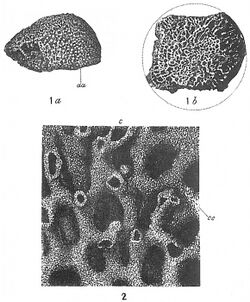Biology:Syringammina fragilissima
| Syringammina fragilissima | |
|---|---|
| Scientific classification | |
| (unranked): | |
| (unranked): | |
| Phylum: | |
| Class: | |
| Order: | Psamminida
|
| Family: | Syringamminidae
|
| Genus: | |
| Species: | S. fragilissima
|
| Binomial name | |
| Syringammina fragilissima Brady, 1883 [1]
| |
Syringammina fragilissima is a xenophyophore found off the coast of Scotland, near Rockall.[2] It is the largest single-cell organism known, at up to 20 centimetres (8 in) across.[3] It was the first xenophyophore to be described,[4] after being discovered in 1882 by the oceanographer John Murray.
The cell grows into hundreds of branched and interconnecting tubes, which secrete an organic cement to collect particles of sediment and sand, forming a crusty structure called the test. As the test grows, the cell withdraws from parts of it, which are then colonised by other organisms, such as nematodes. The cell is multinucleate (it has multiple nuclei).[3]
It is not known how the organism feeds or reproduces. However, it has been shown to have high concentrations of lipids within its cytosol, which suggests that it may feed on bacteria from the sediment that makes up the "sand tubes."[5]
References
- ↑ Ole Tendal (2009). "Syringammina fragillissima Brady, 1883". World Register of Marine Species. http://www.marinespecies.org/aphia.php?p=taxdetails&id=137339. Retrieved February 4, 2010.
- ↑ "As large as life". New Scientist 2157. October 24, 1998. https://www.newscientist.com/article/mg16021573.700-as-large-as-life.html.
- ↑ 3.0 3.1 Michael Marshall (February 3, 2010). "Zoologger: 'Living beach ball' is giant single cell". New Scientist. https://www.newscientist.com/article/dn18468.
- ↑ J. Alan Hughes & Andrew J. Gooday (2004). "Associations between living benthic foraminifera and dead tests of Syringammina fragilissima (Xenophyophorea) in the Darwin Mounds region (NE Atlantic)". Deep-Sea Research Part I: Oceanographic Research Papers 51 (11): 1741–1758. doi:10.1016/j.dsr.2004.06.004.
- ↑ Laureillard, J., L. Méjanelle, and M. Sibuet. "Use of Lipids to Study the Trophic Ecology of Deep-sea Xenophyophores." Marine Ecology Progress Series 270 (2004): 129-40. Print.
External links
- Article containing a photograph of a specimen from New Scientist
Wikidata ☰ Q3020957 entry


